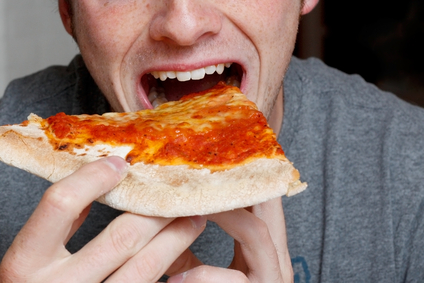by Dr. Craig A. Maxwell
Earlier this year, the website, Vice.com did an article on a man who has lived almost entirely on pizza for the past 25 years. His unusual story prompted social media responses ranging from positive (“You’re our hero!”) to negative (“You’re going to die!”).
What caught my attention was what his doctors had to say. Although 38-year-old Dan Janssen claims his endocrinologist doesn’t approve, the rest of his doctors have said, “Your cholesterol is fine. You seem healthy. Keep doing what you’re doing.”
Dan has insulin-dependent diabetes.
In the short documentary filmed about his unconventional eating habits, he openly states he needs to use more insulin than most diabetics because he doesn’t watch his diet.
Dan’s Food Aversion Began When He Become a Vegetarian
In interviews, Dan claims he used to eat “regular food.” When he was in his mid-teens, however, he became a vegetarian for ethical reasons. Even though he has openly admitted to still craving meat after 25 years without it, he refuses to go back to an omnivorous diet.
The ironic part of Dan’s vegetarianism is he doesn’t like vegetables…of any kind. In the short documentary, he is seen trying to eat a slice of pizza topped with vegetables and is visibly shaken and nearly gags as a result.
Are Janssen’s Doctors Enabling an Eating Disorder?
Although the most widely recognized eating disorders are anorexia and bulimia, there are some lesser-known eating disorders that could indicate the need for therapeutic intervention.
One of these is selective eating disorder, also known as avoidant/restrictive food intake disorder (ARFID), which causes the sufferer to experience extreme aversions to all but a handful of foods.
Unlike anorexia or bulimia, the person with ARFID does not fear gaining weight. Instead, they fear a negative sensory experience associated with food. This usually begins in early childhood and can be the result of a developmental condition like autism or sensory integration disorder.
In Dan’s case, the condition appeared to have developed when he decided to switch to a vegetarian diet. When selective eating disorder surfaces in adulthood, it is usually a sign of hidden anxieties, phobias or childhood trauma coming to the surface.
In the original article, Dan reveals his daycare provider threw him in the closet for hours for refusing to eat her stew. In another food-related trauma, Dan’s sister forced him to eat mushrooms she’d found outside, causing him to be violently ill for 24 hours.
The Rewarding Sensory Experience Caused by Processed Foods
As I was reading Dan’s story and watching the video, it reminded me of an article I read a while back called “The Extraordinary Science of Junk Food“. This article breaks down the exact scientific reasons why junk food is so addictive and how food manufacturers design it this way so their customer base is virtually guaranteed.
Food additives like aspartame, high fructose corn syrup, MSG, and many food dyes have an impact on the pleasure and reward centers of the brain, creating a “food high” without offering any real nourishment.
Dan states that he enjoys the texture and taste of the plain cheese pizza he eats. He describes the soft crust and the cheese mixture in detail and appears to derive feelings of relaxation and pleasure from putting this food into his mouth.
An eating disorder caused by trauma, coupled with this obvious sensory reward, could be what has rewired Dan’s brain to enjoy only this one food and be avoidant of all others.
Cognitive Behavioral Therapy May Help Dan Enjoy a More Varied Diet
Dan’s diabetes will continue to be a health risk until he seeks therapy for his eating disorder. Cognitive behavioral therapy often proves successful in these cases as it helps slowly rewire the brain to be more accepting of sensory stimuli considered intolerable.
Here are the stages Dan would go through:
- Record
In the first stage, he would be asked to record what he eats throughout the day without making any changes to his diet.
- Reward
In the second stage, he would be asked to write a list of foods he would like to try one day. Even if it’s not a new food, it could be pizza prepared in a different way.
- Relax
In the third stage, he would be encouraged to write down and envision himself eating the foods mentioned in the reward stage while feeling relaxed. Then he would try the new food.
- Review
In the final stage, his progress would be checked to be sure his feelings of anxiety have been reduced and his diet is becoming more varied.
The adult picky eater isn’t always stubborn or childish. He or she may have a strong sensory aversion to a wide variety of foods. Thankfully, this condition is treatable. While some may think eating nothing but pizza is “cool”, it can lead to severe nutritional deficiencies and a worsening of mental health problems.
I hope Dan gets the help he needs, and I wish him and his fiancée the best.
Watch the Short Documentary Below:
The Cause of Some Mental Health Disorders May Surprise You
Read Next:








